SH6000 Assessment 2: Leadership and Management Workbook Analysis
VerifiedAdded on 2023/01/12
|9
|4520
|82
Report
AI Summary
This SH6000 Leadership and Management assignment is a comprehensive workbook analyzing management styles, leadership, and change within a professional context. The report is divided into three key sections: management style, leadership, management and change, and leadership, management, and decision-making. The student reflects on group work experiences, applying management theories and change models like Lewin's change model. The analysis includes discussions on participative and affiliative management styles, the importance of fair treatment, and the impact of effective communication within a team. The report also explores how the student's approach to management has evolved, supported by academic references and a reflective approach to learning and development. The assignment demonstrates an understanding of leadership principles and the application of management theories to real-world scenarios.
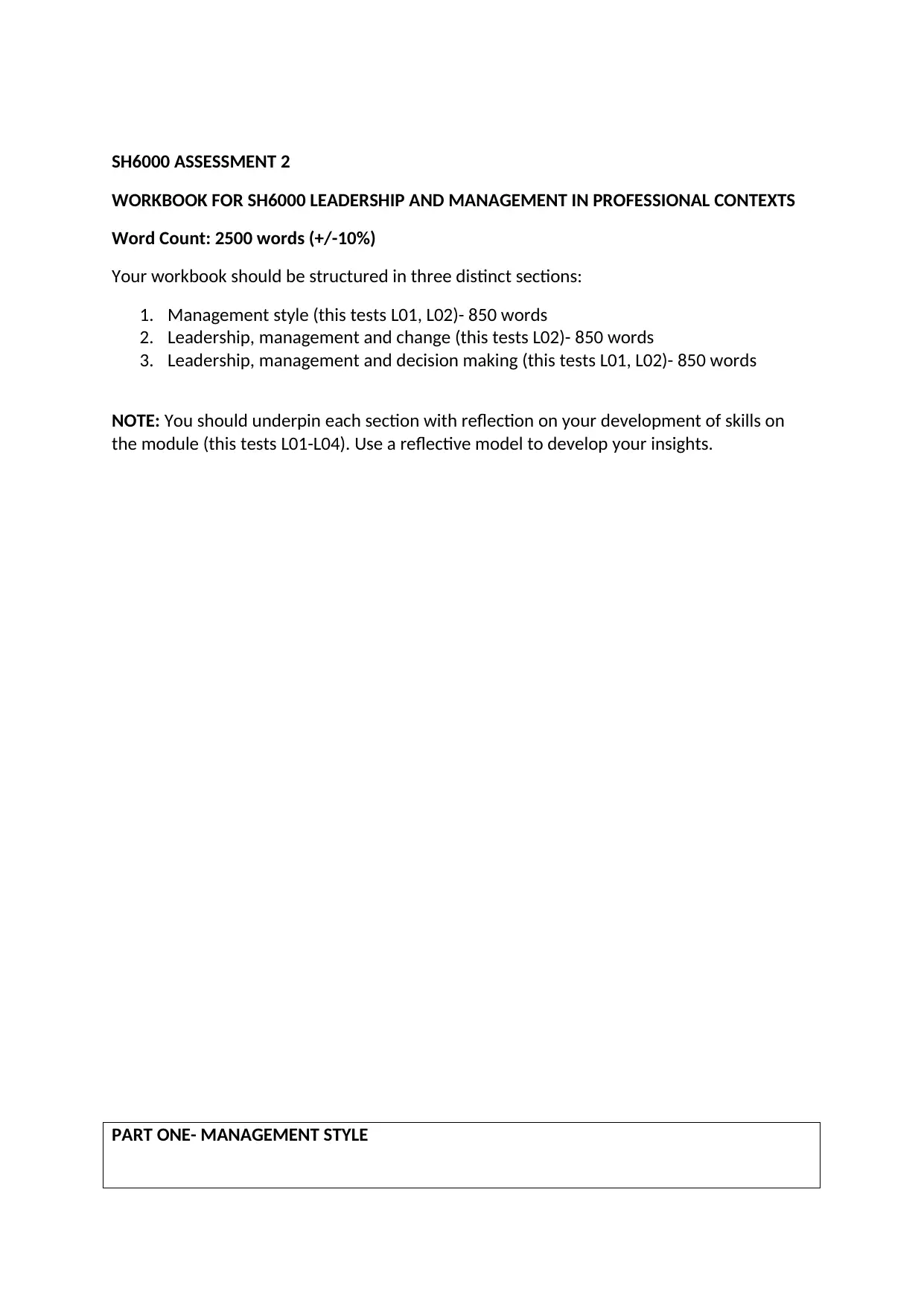
SH6000 ASSESSMENT 2
WORKBOOK FOR SH6000 LEADERSHIP AND MANAGEMENT IN PROFESSIONAL CONTEXTS
Word Count: 2500 words (+/-10%)
Your workbook should be structured in three distinct sections:
1. Management style (this tests L01, L02)- 850 words
2. Leadership, management and change (this tests L02)- 850 words
3. Leadership, management and decision making (this tests L01, L02)- 850 words
NOTE: You should underpin each section with reflection on your development of skills on
the module (this tests L01-L04). Use a reflective model to develop your insights.
PART ONE- MANAGEMENT STYLE
WORKBOOK FOR SH6000 LEADERSHIP AND MANAGEMENT IN PROFESSIONAL CONTEXTS
Word Count: 2500 words (+/-10%)
Your workbook should be structured in three distinct sections:
1. Management style (this tests L01, L02)- 850 words
2. Leadership, management and change (this tests L02)- 850 words
3. Leadership, management and decision making (this tests L01, L02)- 850 words
NOTE: You should underpin each section with reflection on your development of skills on
the module (this tests L01-L04). Use a reflective model to develop your insights.
PART ONE- MANAGEMENT STYLE
Paraphrase This Document
Need a fresh take? Get an instant paraphrase of this document with our AI Paraphraser
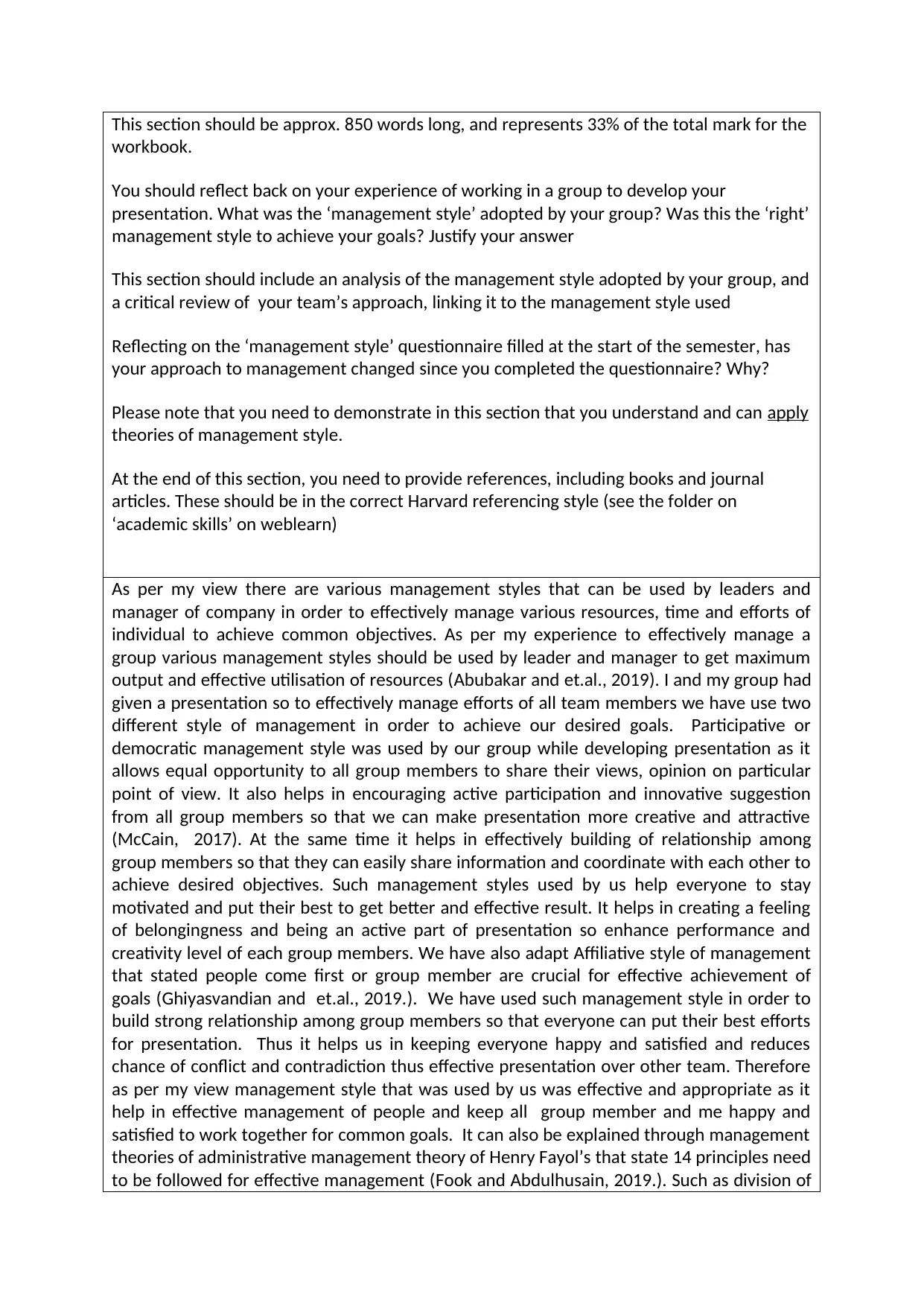
This section should be approx. 850 words long, and represents 33% of the total mark for the
workbook.
You should reflect back on your experience of working in a group to develop your
presentation. What was the ‘management style’ adopted by your group? Was this the ‘right’
management style to achieve your goals? Justify your answer
This section should include an analysis of the management style adopted by your group, and
a critical review of your team’s approach, linking it to the management style used
Reflecting on the ‘management style’ questionnaire filled at the start of the semester, has
your approach to management changed since you completed the questionnaire? Why?
Please note that you need to demonstrate in this section that you understand and can apply
theories of management style.
At the end of this section, you need to provide references, including books and journal
articles. These should be in the correct Harvard referencing style (see the folder on
‘academic skills’ on weblearn)
As per my view there are various management styles that can be used by leaders and
manager of company in order to effectively manage various resources, time and efforts of
individual to achieve common objectives. As per my experience to effectively manage a
group various management styles should be used by leader and manager to get maximum
output and effective utilisation of resources (Abubakar and et.al., 2019). I and my group had
given a presentation so to effectively manage efforts of all team members we have use two
different style of management in order to achieve our desired goals. Participative or
democratic management style was used by our group while developing presentation as it
allows equal opportunity to all group members to share their views, opinion on particular
point of view. It also helps in encouraging active participation and innovative suggestion
from all group members so that we can make presentation more creative and attractive
(McCain, 2017). At the same time it helps in effectively building of relationship among
group members so that they can easily share information and coordinate with each other to
achieve desired objectives. Such management styles used by us help everyone to stay
motivated and put their best to get better and effective result. It helps in creating a feeling
of belongingness and being an active part of presentation so enhance performance and
creativity level of each group members. We have also adapt Affiliative style of management
that stated people come first or group member are crucial for effective achievement of
goals (Ghiyasvandian and et.al., 2019.). We have used such management style in order to
build strong relationship among group members so that everyone can put their best efforts
for presentation. Thus it helps us in keeping everyone happy and satisfied and reduces
chance of conflict and contradiction thus effective presentation over other team. Therefore
as per my view management style that was used by us was effective and appropriate as it
help in effective management of people and keep all group member and me happy and
satisfied to work together for common goals. It can also be explained through management
theories of administrative management theory of Henry Fayol’s that state 14 principles need
to be followed for effective management (Fook and Abdulhusain, 2019.). Such as division of
workbook.
You should reflect back on your experience of working in a group to develop your
presentation. What was the ‘management style’ adopted by your group? Was this the ‘right’
management style to achieve your goals? Justify your answer
This section should include an analysis of the management style adopted by your group, and
a critical review of your team’s approach, linking it to the management style used
Reflecting on the ‘management style’ questionnaire filled at the start of the semester, has
your approach to management changed since you completed the questionnaire? Why?
Please note that you need to demonstrate in this section that you understand and can apply
theories of management style.
At the end of this section, you need to provide references, including books and journal
articles. These should be in the correct Harvard referencing style (see the folder on
‘academic skills’ on weblearn)
As per my view there are various management styles that can be used by leaders and
manager of company in order to effectively manage various resources, time and efforts of
individual to achieve common objectives. As per my experience to effectively manage a
group various management styles should be used by leader and manager to get maximum
output and effective utilisation of resources (Abubakar and et.al., 2019). I and my group had
given a presentation so to effectively manage efforts of all team members we have use two
different style of management in order to achieve our desired goals. Participative or
democratic management style was used by our group while developing presentation as it
allows equal opportunity to all group members to share their views, opinion on particular
point of view. It also helps in encouraging active participation and innovative suggestion
from all group members so that we can make presentation more creative and attractive
(McCain, 2017). At the same time it helps in effectively building of relationship among
group members so that they can easily share information and coordinate with each other to
achieve desired objectives. Such management styles used by us help everyone to stay
motivated and put their best to get better and effective result. It helps in creating a feeling
of belongingness and being an active part of presentation so enhance performance and
creativity level of each group members. We have also adapt Affiliative style of management
that stated people come first or group member are crucial for effective achievement of
goals (Ghiyasvandian and et.al., 2019.). We have used such management style in order to
build strong relationship among group members so that everyone can put their best efforts
for presentation. Thus it helps us in keeping everyone happy and satisfied and reduces
chance of conflict and contradiction thus effective presentation over other team. Therefore
as per my view management style that was used by us was effective and appropriate as it
help in effective management of people and keep all group member and me happy and
satisfied to work together for common goals. It can also be explained through management
theories of administrative management theory of Henry Fayol’s that state 14 principles need
to be followed for effective management (Fook and Abdulhusain, 2019.). Such as division of
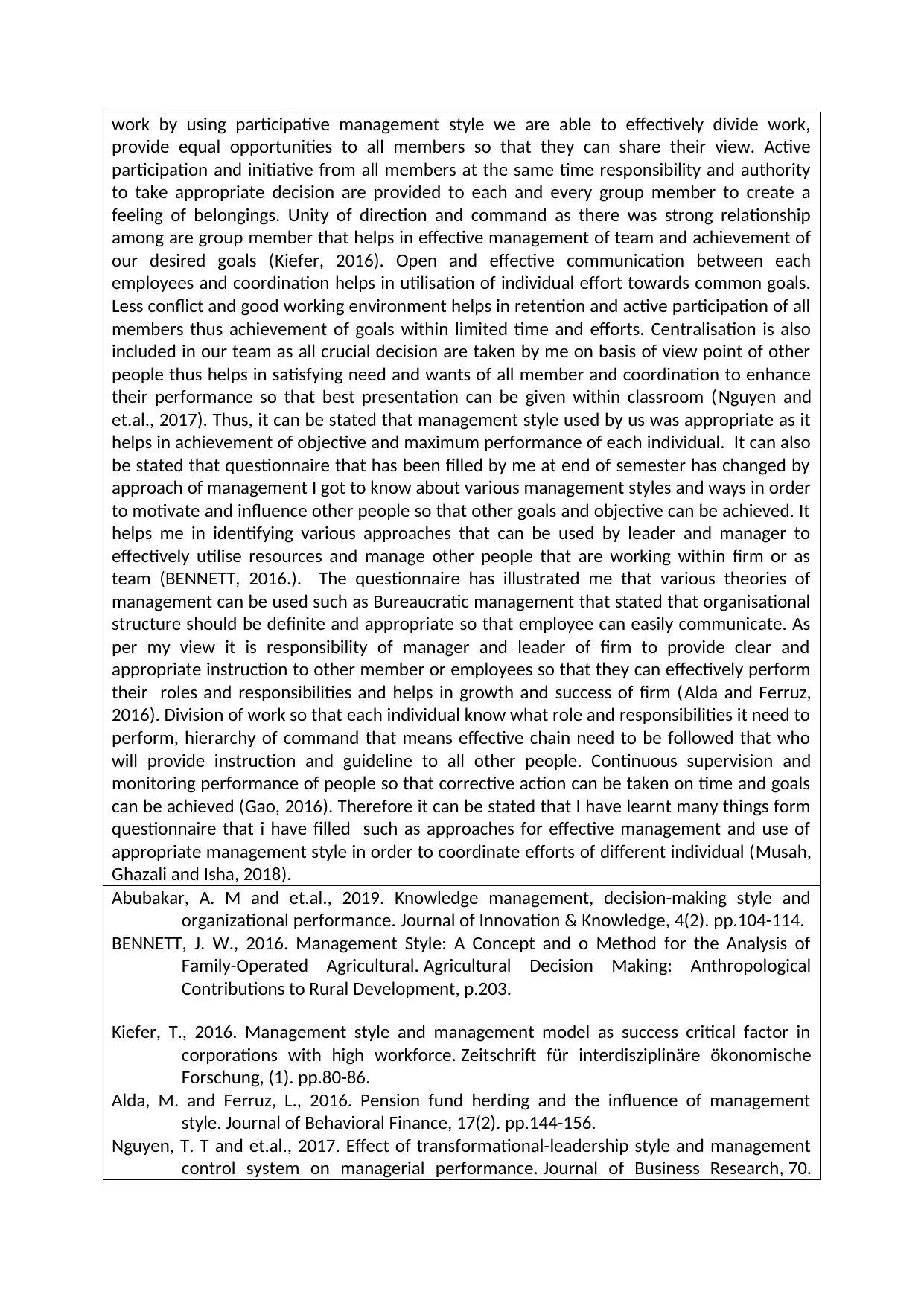
work by using participative management style we are able to effectively divide work,
provide equal opportunities to all members so that they can share their view. Active
participation and initiative from all members at the same time responsibility and authority
to take appropriate decision are provided to each and every group member to create a
feeling of belongings. Unity of direction and command as there was strong relationship
among are group member that helps in effective management of team and achievement of
our desired goals (Kiefer, 2016). Open and effective communication between each
employees and coordination helps in utilisation of individual effort towards common goals.
Less conflict and good working environment helps in retention and active participation of all
members thus achievement of goals within limited time and efforts. Centralisation is also
included in our team as all crucial decision are taken by me on basis of view point of other
people thus helps in satisfying need and wants of all member and coordination to enhance
their performance so that best presentation can be given within classroom (Nguyen and
et.al., 2017). Thus, it can be stated that management style used by us was appropriate as it
helps in achievement of objective and maximum performance of each individual. It can also
be stated that questionnaire that has been filled by me at end of semester has changed by
approach of management I got to know about various management styles and ways in order
to motivate and influence other people so that other goals and objective can be achieved. It
helps me in identifying various approaches that can be used by leader and manager to
effectively utilise resources and manage other people that are working within firm or as
team (BENNETT, 2016.). The questionnaire has illustrated me that various theories of
management can be used such as Bureaucratic management that stated that organisational
structure should be definite and appropriate so that employee can easily communicate. As
per my view it is responsibility of manager and leader of firm to provide clear and
appropriate instruction to other member or employees so that they can effectively perform
their roles and responsibilities and helps in growth and success of firm (Alda and Ferruz,
2016). Division of work so that each individual know what role and responsibilities it need to
perform, hierarchy of command that means effective chain need to be followed that who
will provide instruction and guideline to all other people. Continuous supervision and
monitoring performance of people so that corrective action can be taken on time and goals
can be achieved (Gao, 2016). Therefore it can be stated that I have learnt many things form
questionnaire that i have filled such as approaches for effective management and use of
appropriate management style in order to coordinate efforts of different individual (Musah,
Ghazali and Isha, 2018).
Abubakar, A. M and et.al., 2019. Knowledge management, decision-making style and
organizational performance. Journal of Innovation & Knowledge, 4(2). pp.104-114.
BENNETT, J. W., 2016. Management Style: A Concept and o Method for the Analysis of
Family-Operated Agricultural. Agricultural Decision Making: Anthropological
Contributions to Rural Development, p.203.
Kiefer, T., 2016. Management style and management model as success critical factor in
corporations with high workforce. Zeitschrift für interdisziplinäre ökonomische
Forschung, (1). pp.80-86.
Alda, M. and Ferruz, L., 2016. Pension fund herding and the influence of management
style. Journal of Behavioral Finance, 17(2). pp.144-156.
Nguyen, T. T and et.al., 2017. Effect of transformational-leadership style and management
control system on managerial performance. Journal of Business Research, 70.
provide equal opportunities to all members so that they can share their view. Active
participation and initiative from all members at the same time responsibility and authority
to take appropriate decision are provided to each and every group member to create a
feeling of belongings. Unity of direction and command as there was strong relationship
among are group member that helps in effective management of team and achievement of
our desired goals (Kiefer, 2016). Open and effective communication between each
employees and coordination helps in utilisation of individual effort towards common goals.
Less conflict and good working environment helps in retention and active participation of all
members thus achievement of goals within limited time and efforts. Centralisation is also
included in our team as all crucial decision are taken by me on basis of view point of other
people thus helps in satisfying need and wants of all member and coordination to enhance
their performance so that best presentation can be given within classroom (Nguyen and
et.al., 2017). Thus, it can be stated that management style used by us was appropriate as it
helps in achievement of objective and maximum performance of each individual. It can also
be stated that questionnaire that has been filled by me at end of semester has changed by
approach of management I got to know about various management styles and ways in order
to motivate and influence other people so that other goals and objective can be achieved. It
helps me in identifying various approaches that can be used by leader and manager to
effectively utilise resources and manage other people that are working within firm or as
team (BENNETT, 2016.). The questionnaire has illustrated me that various theories of
management can be used such as Bureaucratic management that stated that organisational
structure should be definite and appropriate so that employee can easily communicate. As
per my view it is responsibility of manager and leader of firm to provide clear and
appropriate instruction to other member or employees so that they can effectively perform
their roles and responsibilities and helps in growth and success of firm (Alda and Ferruz,
2016). Division of work so that each individual know what role and responsibilities it need to
perform, hierarchy of command that means effective chain need to be followed that who
will provide instruction and guideline to all other people. Continuous supervision and
monitoring performance of people so that corrective action can be taken on time and goals
can be achieved (Gao, 2016). Therefore it can be stated that I have learnt many things form
questionnaire that i have filled such as approaches for effective management and use of
appropriate management style in order to coordinate efforts of different individual (Musah,
Ghazali and Isha, 2018).
Abubakar, A. M and et.al., 2019. Knowledge management, decision-making style and
organizational performance. Journal of Innovation & Knowledge, 4(2). pp.104-114.
BENNETT, J. W., 2016. Management Style: A Concept and o Method for the Analysis of
Family-Operated Agricultural. Agricultural Decision Making: Anthropological
Contributions to Rural Development, p.203.
Kiefer, T., 2016. Management style and management model as success critical factor in
corporations with high workforce. Zeitschrift für interdisziplinäre ökonomische
Forschung, (1). pp.80-86.
Alda, M. and Ferruz, L., 2016. Pension fund herding and the influence of management
style. Journal of Behavioral Finance, 17(2). pp.144-156.
Nguyen, T. T and et.al., 2017. Effect of transformational-leadership style and management
control system on managerial performance. Journal of Business Research, 70.
⊘ This is a preview!⊘
Do you want full access?
Subscribe today to unlock all pages.

Trusted by 1+ million students worldwide
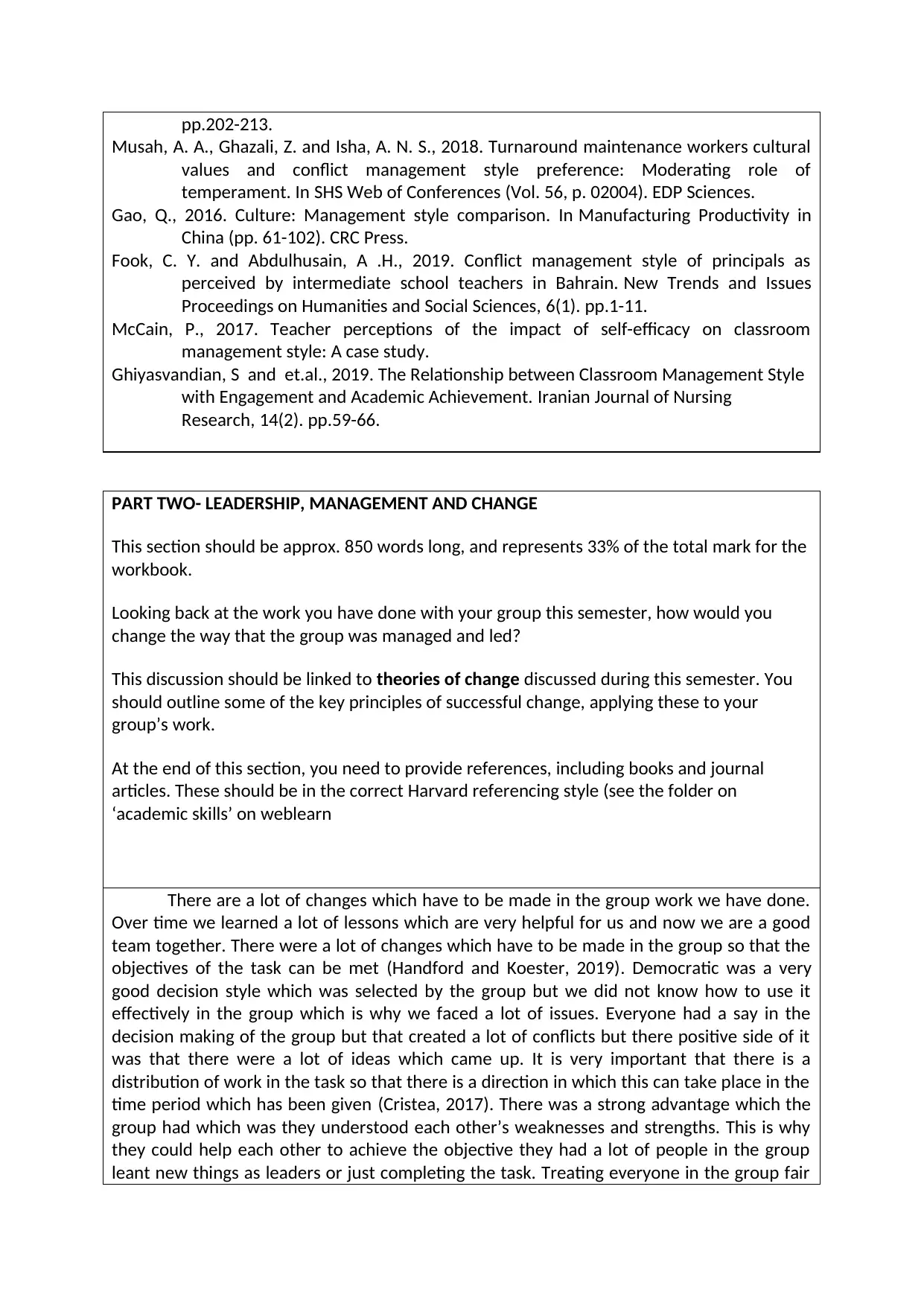
pp.202-213.
Musah, A. A., Ghazali, Z. and Isha, A. N. S., 2018. Turnaround maintenance workers cultural
values and conflict management style preference: Moderating role of
temperament. In SHS Web of Conferences (Vol. 56, p. 02004). EDP Sciences.
Gao, Q., 2016. Culture: Management style comparison. In Manufacturing Productivity in
China (pp. 61-102). CRC Press.
Fook, C. Y. and Abdulhusain, A .H., 2019. Conflict management style of principals as
perceived by intermediate school teachers in Bahrain. New Trends and Issues
Proceedings on Humanities and Social Sciences, 6(1). pp.1-11.
McCain, P., 2017. Teacher perceptions of the impact of self-efficacy on classroom
management style: A case study.
Ghiyasvandian, S and et.al., 2019. The Relationship between Classroom Management Style
with Engagement and Academic Achievement. Iranian Journal of Nursing
Research, 14(2). pp.59-66.
PART TWO- LEADERSHIP, MANAGEMENT AND CHANGE
This section should be approx. 850 words long, and represents 33% of the total mark for the
workbook.
Looking back at the work you have done with your group this semester, how would you
change the way that the group was managed and led?
This discussion should be linked to theories of change discussed during this semester. You
should outline some of the key principles of successful change, applying these to your
group’s work.
At the end of this section, you need to provide references, including books and journal
articles. These should be in the correct Harvard referencing style (see the folder on
‘academic skills’ on weblearn
There are a lot of changes which have to be made in the group work we have done.
Over time we learned a lot of lessons which are very helpful for us and now we are a good
team together. There were a lot of changes which have to be made in the group so that the
objectives of the task can be met (Handford and Koester, 2019). Democratic was a very
good decision style which was selected by the group but we did not know how to use it
effectively in the group which is why we faced a lot of issues. Everyone had a say in the
decision making of the group but that created a lot of conflicts but there positive side of it
was that there were a lot of ideas which came up. It is very important that there is a
distribution of work in the task so that there is a direction in which this can take place in the
time period which has been given (Cristea, 2017). There was a strong advantage which the
group had which was they understood each other’s weaknesses and strengths. This is why
they could help each other to achieve the objective they had a lot of people in the group
leant new things as leaders or just completing the task. Treating everyone in the group fair
Musah, A. A., Ghazali, Z. and Isha, A. N. S., 2018. Turnaround maintenance workers cultural
values and conflict management style preference: Moderating role of
temperament. In SHS Web of Conferences (Vol. 56, p. 02004). EDP Sciences.
Gao, Q., 2016. Culture: Management style comparison. In Manufacturing Productivity in
China (pp. 61-102). CRC Press.
Fook, C. Y. and Abdulhusain, A .H., 2019. Conflict management style of principals as
perceived by intermediate school teachers in Bahrain. New Trends and Issues
Proceedings on Humanities and Social Sciences, 6(1). pp.1-11.
McCain, P., 2017. Teacher perceptions of the impact of self-efficacy on classroom
management style: A case study.
Ghiyasvandian, S and et.al., 2019. The Relationship between Classroom Management Style
with Engagement and Academic Achievement. Iranian Journal of Nursing
Research, 14(2). pp.59-66.
PART TWO- LEADERSHIP, MANAGEMENT AND CHANGE
This section should be approx. 850 words long, and represents 33% of the total mark for the
workbook.
Looking back at the work you have done with your group this semester, how would you
change the way that the group was managed and led?
This discussion should be linked to theories of change discussed during this semester. You
should outline some of the key principles of successful change, applying these to your
group’s work.
At the end of this section, you need to provide references, including books and journal
articles. These should be in the correct Harvard referencing style (see the folder on
‘academic skills’ on weblearn
There are a lot of changes which have to be made in the group work we have done.
Over time we learned a lot of lessons which are very helpful for us and now we are a good
team together. There were a lot of changes which have to be made in the group so that the
objectives of the task can be met (Handford and Koester, 2019). Democratic was a very
good decision style which was selected by the group but we did not know how to use it
effectively in the group which is why we faced a lot of issues. Everyone had a say in the
decision making of the group but that created a lot of conflicts but there positive side of it
was that there were a lot of ideas which came up. It is very important that there is a
distribution of work in the task so that there is a direction in which this can take place in the
time period which has been given (Cristea, 2017). There was a strong advantage which the
group had which was they understood each other’s weaknesses and strengths. This is why
they could help each other to achieve the objective they had a lot of people in the group
leant new things as leaders or just completing the task. Treating everyone in the group fair
Paraphrase This Document
Need a fresh take? Get an instant paraphrase of this document with our AI Paraphraser
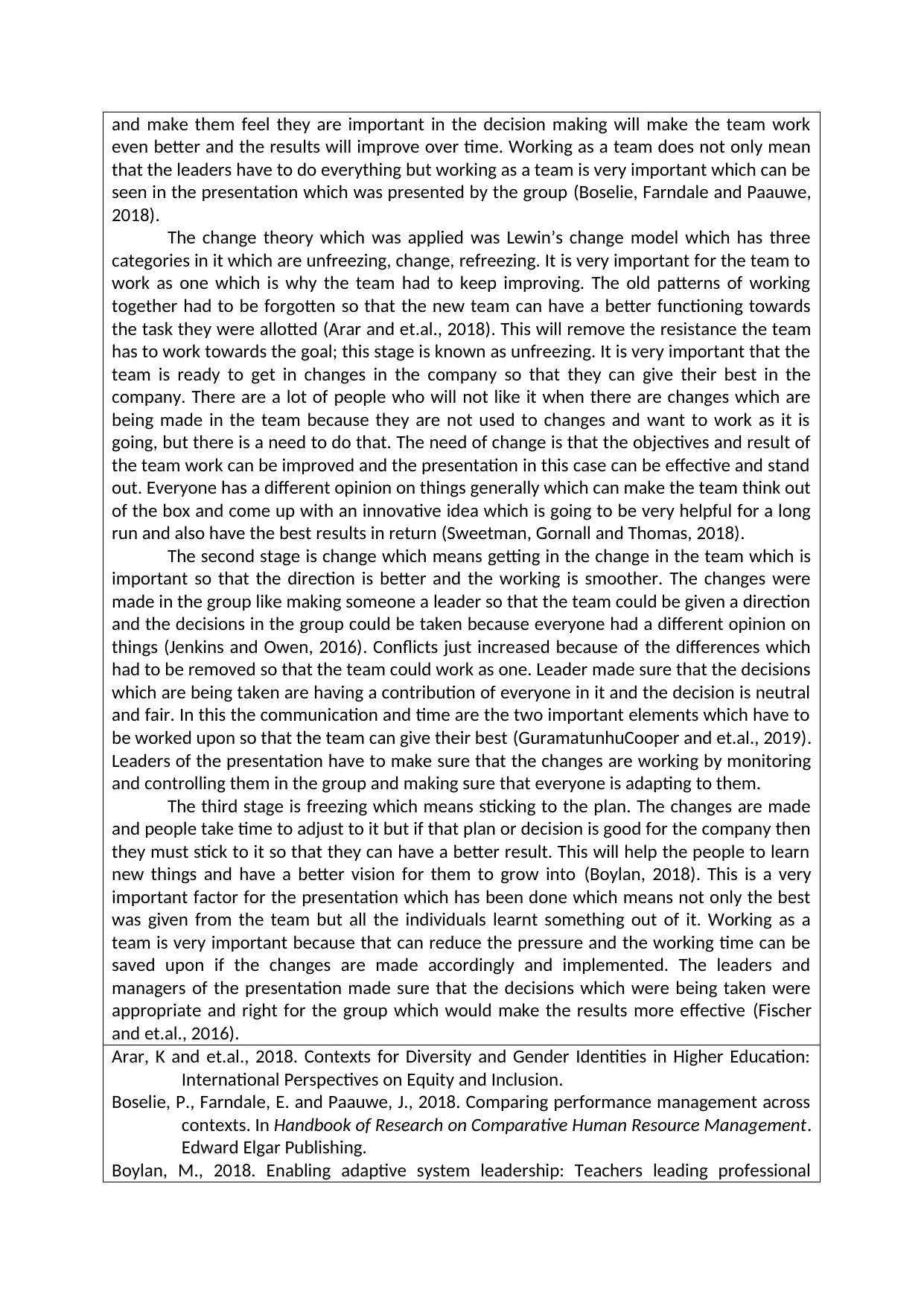
and make them feel they are important in the decision making will make the team work
even better and the results will improve over time. Working as a team does not only mean
that the leaders have to do everything but working as a team is very important which can be
seen in the presentation which was presented by the group (Boselie, Farndale and Paauwe,
2018).
The change theory which was applied was Lewin’s change model which has three
categories in it which are unfreezing, change, refreezing. It is very important for the team to
work as one which is why the team had to keep improving. The old patterns of working
together had to be forgotten so that the new team can have a better functioning towards
the task they were allotted (Arar and et.al., 2018). This will remove the resistance the team
has to work towards the goal; this stage is known as unfreezing. It is very important that the
team is ready to get in changes in the company so that they can give their best in the
company. There are a lot of people who will not like it when there are changes which are
being made in the team because they are not used to changes and want to work as it is
going, but there is a need to do that. The need of change is that the objectives and result of
the team work can be improved and the presentation in this case can be effective and stand
out. Everyone has a different opinion on things generally which can make the team think out
of the box and come up with an innovative idea which is going to be very helpful for a long
run and also have the best results in return (Sweetman, Gornall and Thomas, 2018).
The second stage is change which means getting in the change in the team which is
important so that the direction is better and the working is smoother. The changes were
made in the group like making someone a leader so that the team could be given a direction
and the decisions in the group could be taken because everyone had a different opinion on
things (Jenkins and Owen, 2016). Conflicts just increased because of the differences which
had to be removed so that the team could work as one. Leader made sure that the decisions
which are being taken are having a contribution of everyone in it and the decision is neutral
and fair. In this the communication and time are the two important elements which have to
be worked upon so that the team can give their best (GuramatunhuCooper and et.al., 2019).
Leaders of the presentation have to make sure that the changes are working by monitoring
and controlling them in the group and making sure that everyone is adapting to them.
The third stage is freezing which means sticking to the plan. The changes are made
and people take time to adjust to it but if that plan or decision is good for the company then
they must stick to it so that they can have a better result. This will help the people to learn
new things and have a better vision for them to grow into (Boylan, 2018). This is a very
important factor for the presentation which has been done which means not only the best
was given from the team but all the individuals learnt something out of it. Working as a
team is very important because that can reduce the pressure and the working time can be
saved upon if the changes are made accordingly and implemented. The leaders and
managers of the presentation made sure that the decisions which were being taken were
appropriate and right for the group which would make the results more effective (Fischer
and et.al., 2016).
Arar, K and et.al., 2018. Contexts for Diversity and Gender Identities in Higher Education:
International Perspectives on Equity and Inclusion.
Boselie, P., Farndale, E. and Paauwe, J., 2018. Comparing performance management across
contexts. In Handbook of Research on Comparative Human Resource Management.
Edward Elgar Publishing.
Boylan, M., 2018. Enabling adaptive system leadership: Teachers leading professional
even better and the results will improve over time. Working as a team does not only mean
that the leaders have to do everything but working as a team is very important which can be
seen in the presentation which was presented by the group (Boselie, Farndale and Paauwe,
2018).
The change theory which was applied was Lewin’s change model which has three
categories in it which are unfreezing, change, refreezing. It is very important for the team to
work as one which is why the team had to keep improving. The old patterns of working
together had to be forgotten so that the new team can have a better functioning towards
the task they were allotted (Arar and et.al., 2018). This will remove the resistance the team
has to work towards the goal; this stage is known as unfreezing. It is very important that the
team is ready to get in changes in the company so that they can give their best in the
company. There are a lot of people who will not like it when there are changes which are
being made in the team because they are not used to changes and want to work as it is
going, but there is a need to do that. The need of change is that the objectives and result of
the team work can be improved and the presentation in this case can be effective and stand
out. Everyone has a different opinion on things generally which can make the team think out
of the box and come up with an innovative idea which is going to be very helpful for a long
run and also have the best results in return (Sweetman, Gornall and Thomas, 2018).
The second stage is change which means getting in the change in the team which is
important so that the direction is better and the working is smoother. The changes were
made in the group like making someone a leader so that the team could be given a direction
and the decisions in the group could be taken because everyone had a different opinion on
things (Jenkins and Owen, 2016). Conflicts just increased because of the differences which
had to be removed so that the team could work as one. Leader made sure that the decisions
which are being taken are having a contribution of everyone in it and the decision is neutral
and fair. In this the communication and time are the two important elements which have to
be worked upon so that the team can give their best (GuramatunhuCooper and et.al., 2019).
Leaders of the presentation have to make sure that the changes are working by monitoring
and controlling them in the group and making sure that everyone is adapting to them.
The third stage is freezing which means sticking to the plan. The changes are made
and people take time to adjust to it but if that plan or decision is good for the company then
they must stick to it so that they can have a better result. This will help the people to learn
new things and have a better vision for them to grow into (Boylan, 2018). This is a very
important factor for the presentation which has been done which means not only the best
was given from the team but all the individuals learnt something out of it. Working as a
team is very important because that can reduce the pressure and the working time can be
saved upon if the changes are made accordingly and implemented. The leaders and
managers of the presentation made sure that the decisions which were being taken were
appropriate and right for the group which would make the results more effective (Fischer
and et.al., 2016).
Arar, K and et.al., 2018. Contexts for Diversity and Gender Identities in Higher Education:
International Perspectives on Equity and Inclusion.
Boselie, P., Farndale, E. and Paauwe, J., 2018. Comparing performance management across
contexts. In Handbook of Research on Comparative Human Resource Management.
Edward Elgar Publishing.
Boylan, M., 2018. Enabling adaptive system leadership: Teachers leading professional
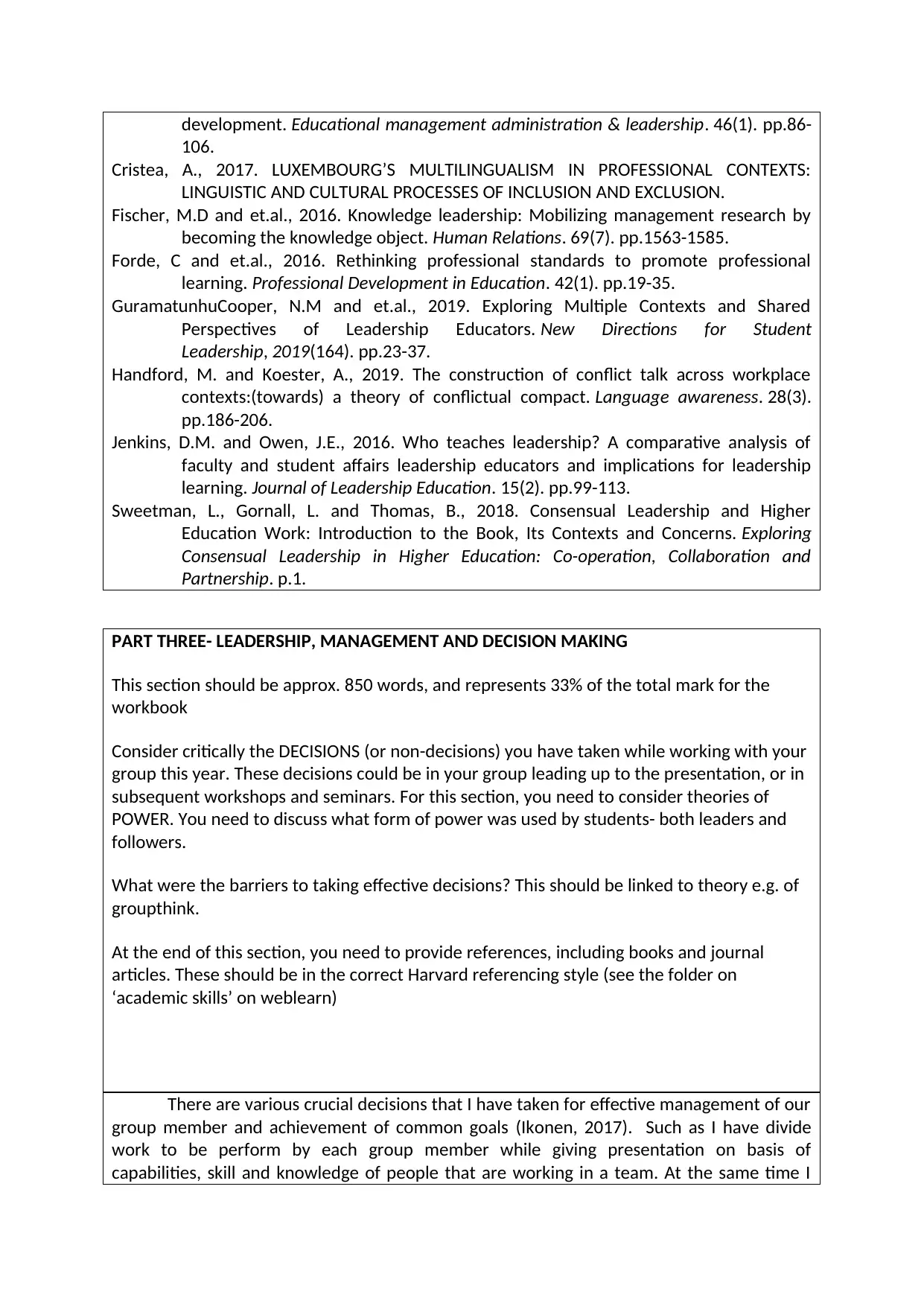
development. Educational management administration & leadership. 46(1). pp.86-
106.
Cristea, A., 2017. LUXEMBOURG’S MULTILINGUALISM IN PROFESSIONAL CONTEXTS:
LINGUISTIC AND CULTURAL PROCESSES OF INCLUSION AND EXCLUSION.
Fischer, M.D and et.al., 2016. Knowledge leadership: Mobilizing management research by
becoming the knowledge object. Human Relations. 69(7). pp.1563-1585.
Forde, C and et.al., 2016. Rethinking professional standards to promote professional
learning. Professional Development in Education. 42(1). pp.19-35.
GuramatunhuCooper, N.M and et.al., 2019. Exploring Multiple Contexts and Shared
Perspectives of Leadership Educators. New Directions for Student
Leadership, 2019(164). pp.23-37.
Handford, M. and Koester, A., 2019. The construction of conflict talk across workplace
contexts:(towards) a theory of conflictual compact. Language awareness. 28(3).
pp.186-206.
Jenkins, D.M. and Owen, J.E., 2016. Who teaches leadership? A comparative analysis of
faculty and student affairs leadership educators and implications for leadership
learning. Journal of Leadership Education. 15(2). pp.99-113.
Sweetman, L., Gornall, L. and Thomas, B., 2018. Consensual Leadership and Higher
Education Work: Introduction to the Book, Its Contexts and Concerns. Exploring
Consensual Leadership in Higher Education: Co-operation, Collaboration and
Partnership. p.1.
PART THREE- LEADERSHIP, MANAGEMENT AND DECISION MAKING
This section should be approx. 850 words, and represents 33% of the total mark for the
workbook
Consider critically the DECISIONS (or non-decisions) you have taken while working with your
group this year. These decisions could be in your group leading up to the presentation, or in
subsequent workshops and seminars. For this section, you need to consider theories of
POWER. You need to discuss what form of power was used by students- both leaders and
followers.
What were the barriers to taking effective decisions? This should be linked to theory e.g. of
groupthink.
At the end of this section, you need to provide references, including books and journal
articles. These should be in the correct Harvard referencing style (see the folder on
‘academic skills’ on weblearn)
There are various crucial decisions that I have taken for effective management of our
group member and achievement of common goals (Ikonen, 2017). Such as I have divide
work to be perform by each group member while giving presentation on basis of
capabilities, skill and knowledge of people that are working in a team. At the same time I
106.
Cristea, A., 2017. LUXEMBOURG’S MULTILINGUALISM IN PROFESSIONAL CONTEXTS:
LINGUISTIC AND CULTURAL PROCESSES OF INCLUSION AND EXCLUSION.
Fischer, M.D and et.al., 2016. Knowledge leadership: Mobilizing management research by
becoming the knowledge object. Human Relations. 69(7). pp.1563-1585.
Forde, C and et.al., 2016. Rethinking professional standards to promote professional
learning. Professional Development in Education. 42(1). pp.19-35.
GuramatunhuCooper, N.M and et.al., 2019. Exploring Multiple Contexts and Shared
Perspectives of Leadership Educators. New Directions for Student
Leadership, 2019(164). pp.23-37.
Handford, M. and Koester, A., 2019. The construction of conflict talk across workplace
contexts:(towards) a theory of conflictual compact. Language awareness. 28(3).
pp.186-206.
Jenkins, D.M. and Owen, J.E., 2016. Who teaches leadership? A comparative analysis of
faculty and student affairs leadership educators and implications for leadership
learning. Journal of Leadership Education. 15(2). pp.99-113.
Sweetman, L., Gornall, L. and Thomas, B., 2018. Consensual Leadership and Higher
Education Work: Introduction to the Book, Its Contexts and Concerns. Exploring
Consensual Leadership in Higher Education: Co-operation, Collaboration and
Partnership. p.1.
PART THREE- LEADERSHIP, MANAGEMENT AND DECISION MAKING
This section should be approx. 850 words, and represents 33% of the total mark for the
workbook
Consider critically the DECISIONS (or non-decisions) you have taken while working with your
group this year. These decisions could be in your group leading up to the presentation, or in
subsequent workshops and seminars. For this section, you need to consider theories of
POWER. You need to discuss what form of power was used by students- both leaders and
followers.
What were the barriers to taking effective decisions? This should be linked to theory e.g. of
groupthink.
At the end of this section, you need to provide references, including books and journal
articles. These should be in the correct Harvard referencing style (see the folder on
‘academic skills’ on weblearn)
There are various crucial decisions that I have taken for effective management of our
group member and achievement of common goals (Ikonen, 2017). Such as I have divide
work to be perform by each group member while giving presentation on basis of
capabilities, skill and knowledge of people that are working in a team. At the same time I
⊘ This is a preview!⊘
Do you want full access?
Subscribe today to unlock all pages.

Trusted by 1+ million students worldwide
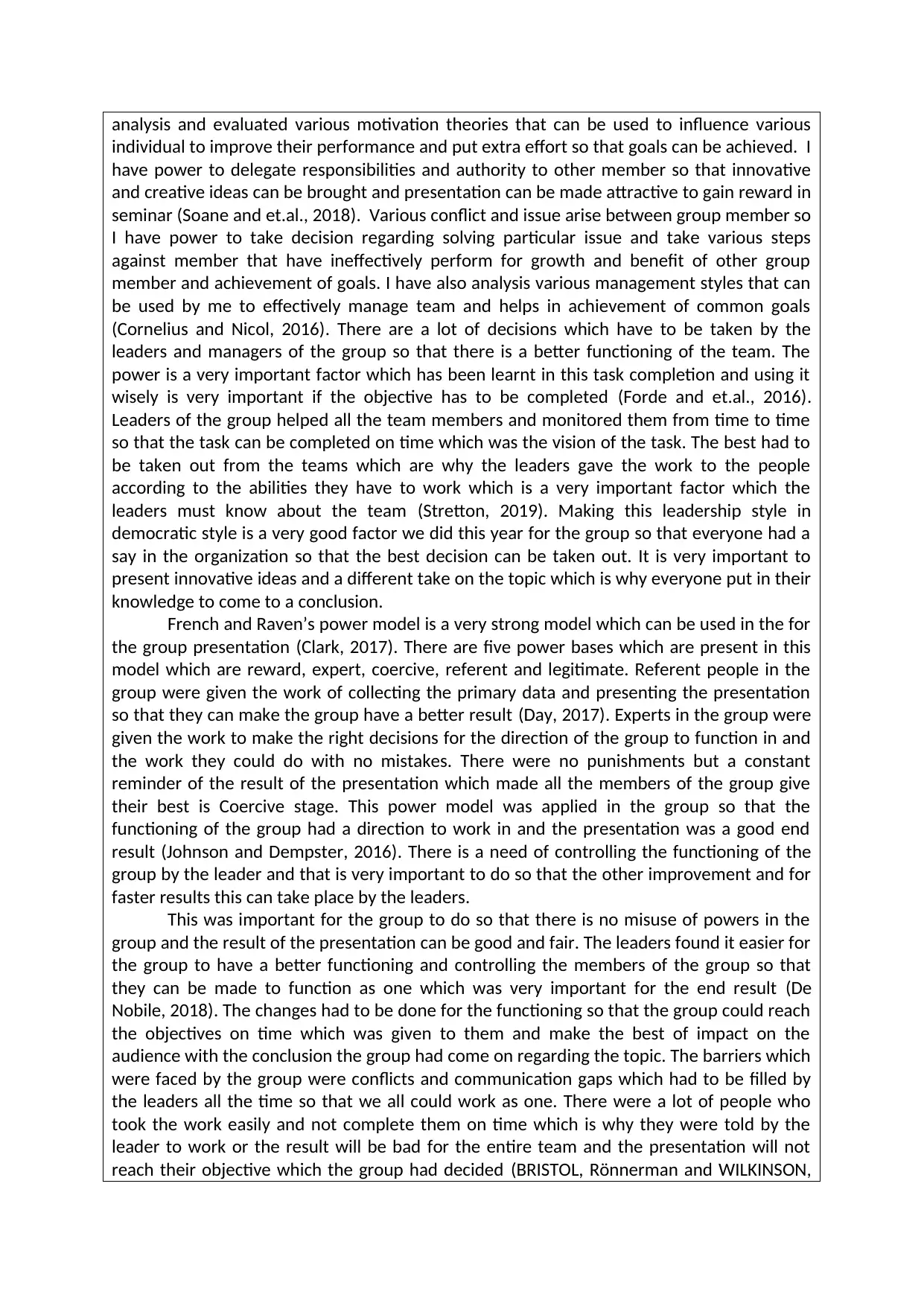
analysis and evaluated various motivation theories that can be used to influence various
individual to improve their performance and put extra effort so that goals can be achieved. I
have power to delegate responsibilities and authority to other member so that innovative
and creative ideas can be brought and presentation can be made attractive to gain reward in
seminar (Soane and et.al., 2018). Various conflict and issue arise between group member so
I have power to take decision regarding solving particular issue and take various steps
against member that have ineffectively perform for growth and benefit of other group
member and achievement of goals. I have also analysis various management styles that can
be used by me to effectively manage team and helps in achievement of common goals
(Cornelius and Nicol, 2016). There are a lot of decisions which have to be taken by the
leaders and managers of the group so that there is a better functioning of the team. The
power is a very important factor which has been learnt in this task completion and using it
wisely is very important if the objective has to be completed (Forde and et.al., 2016).
Leaders of the group helped all the team members and monitored them from time to time
so that the task can be completed on time which was the vision of the task. The best had to
be taken out from the teams which are why the leaders gave the work to the people
according to the abilities they have to work which is a very important factor which the
leaders must know about the team (Stretton, 2019). Making this leadership style in
democratic style is a very good factor we did this year for the group so that everyone had a
say in the organization so that the best decision can be taken out. It is very important to
present innovative ideas and a different take on the topic which is why everyone put in their
knowledge to come to a conclusion.
French and Raven’s power model is a very strong model which can be used in the for
the group presentation (Clark, 2017). There are five power bases which are present in this
model which are reward, expert, coercive, referent and legitimate. Referent people in the
group were given the work of collecting the primary data and presenting the presentation
so that they can make the group have a better result (Day, 2017). Experts in the group were
given the work to make the right decisions for the direction of the group to function in and
the work they could do with no mistakes. There were no punishments but a constant
reminder of the result of the presentation which made all the members of the group give
their best is Coercive stage. This power model was applied in the group so that the
functioning of the group had a direction to work in and the presentation was a good end
result (Johnson and Dempster, 2016). There is a need of controlling the functioning of the
group by the leader and that is very important to do so that the other improvement and for
faster results this can take place by the leaders.
This was important for the group to do so that there is no misuse of powers in the
group and the result of the presentation can be good and fair. The leaders found it easier for
the group to have a better functioning and controlling the members of the group so that
they can be made to function as one which was very important for the end result (De
Nobile, 2018). The changes had to be done for the functioning so that the group could reach
the objectives on time which was given to them and make the best of impact on the
audience with the conclusion the group had come on regarding the topic. The barriers which
were faced by the group were conflicts and communication gaps which had to be filled by
the leaders all the time so that we all could work as one. There were a lot of people who
took the work easily and not complete them on time which is why they were told by the
leader to work or the result will be bad for the entire team and the presentation will not
reach their objective which the group had decided (BRISTOL, Rönnerman and WILKINSON,
individual to improve their performance and put extra effort so that goals can be achieved. I
have power to delegate responsibilities and authority to other member so that innovative
and creative ideas can be brought and presentation can be made attractive to gain reward in
seminar (Soane and et.al., 2018). Various conflict and issue arise between group member so
I have power to take decision regarding solving particular issue and take various steps
against member that have ineffectively perform for growth and benefit of other group
member and achievement of goals. I have also analysis various management styles that can
be used by me to effectively manage team and helps in achievement of common goals
(Cornelius and Nicol, 2016). There are a lot of decisions which have to be taken by the
leaders and managers of the group so that there is a better functioning of the team. The
power is a very important factor which has been learnt in this task completion and using it
wisely is very important if the objective has to be completed (Forde and et.al., 2016).
Leaders of the group helped all the team members and monitored them from time to time
so that the task can be completed on time which was the vision of the task. The best had to
be taken out from the teams which are why the leaders gave the work to the people
according to the abilities they have to work which is a very important factor which the
leaders must know about the team (Stretton, 2019). Making this leadership style in
democratic style is a very good factor we did this year for the group so that everyone had a
say in the organization so that the best decision can be taken out. It is very important to
present innovative ideas and a different take on the topic which is why everyone put in their
knowledge to come to a conclusion.
French and Raven’s power model is a very strong model which can be used in the for
the group presentation (Clark, 2017). There are five power bases which are present in this
model which are reward, expert, coercive, referent and legitimate. Referent people in the
group were given the work of collecting the primary data and presenting the presentation
so that they can make the group have a better result (Day, 2017). Experts in the group were
given the work to make the right decisions for the direction of the group to function in and
the work they could do with no mistakes. There were no punishments but a constant
reminder of the result of the presentation which made all the members of the group give
their best is Coercive stage. This power model was applied in the group so that the
functioning of the group had a direction to work in and the presentation was a good end
result (Johnson and Dempster, 2016). There is a need of controlling the functioning of the
group by the leader and that is very important to do so that the other improvement and for
faster results this can take place by the leaders.
This was important for the group to do so that there is no misuse of powers in the
group and the result of the presentation can be good and fair. The leaders found it easier for
the group to have a better functioning and controlling the members of the group so that
they can be made to function as one which was very important for the end result (De
Nobile, 2018). The changes had to be done for the functioning so that the group could reach
the objectives on time which was given to them and make the best of impact on the
audience with the conclusion the group had come on regarding the topic. The barriers which
were faced by the group were conflicts and communication gaps which had to be filled by
the leaders all the time so that we all could work as one. There were a lot of people who
took the work easily and not complete them on time which is why they were told by the
leader to work or the result will be bad for the entire team and the presentation will not
reach their objective which the group had decided (BRISTOL, Rönnerman and WILKINSON,
Paraphrase This Document
Need a fresh take? Get an instant paraphrase of this document with our AI Paraphraser
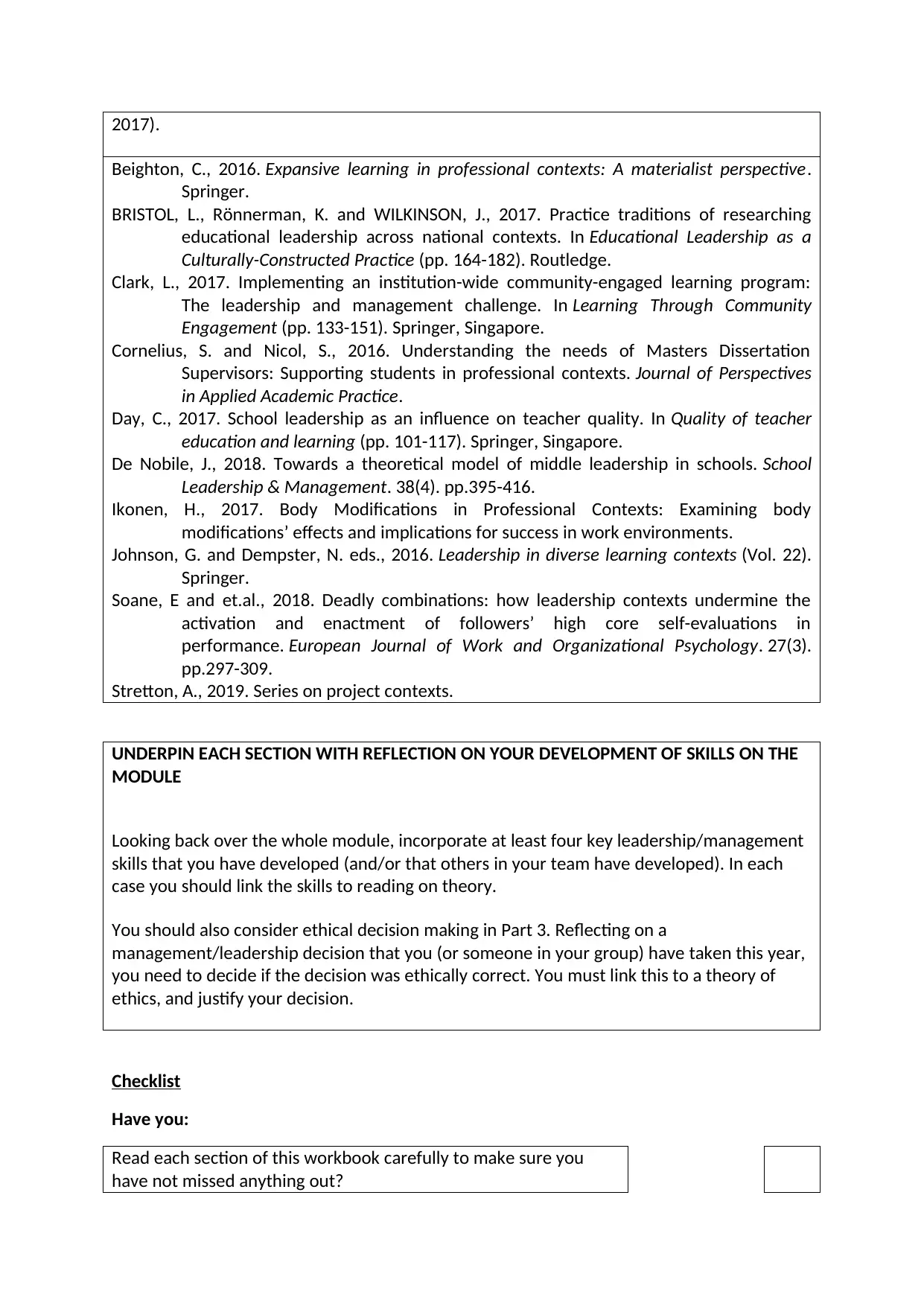
2017).
Beighton, C., 2016. Expansive learning in professional contexts: A materialist perspective.
Springer.
BRISTOL, L., Rönnerman, K. and WILKINSON, J., 2017. Practice traditions of researching
educational leadership across national contexts. In Educational Leadership as a
Culturally-Constructed Practice (pp. 164-182). Routledge.
Clark, L., 2017. Implementing an institution-wide community-engaged learning program:
The leadership and management challenge. In Learning Through Community
Engagement (pp. 133-151). Springer, Singapore.
Cornelius, S. and Nicol, S., 2016. Understanding the needs of Masters Dissertation
Supervisors: Supporting students in professional contexts. Journal of Perspectives
in Applied Academic Practice.
Day, C., 2017. School leadership as an influence on teacher quality. In Quality of teacher
education and learning (pp. 101-117). Springer, Singapore.
De Nobile, J., 2018. Towards a theoretical model of middle leadership in schools. School
Leadership & Management. 38(4). pp.395-416.
Ikonen, H., 2017. Body Modifications in Professional Contexts: Examining body
modifications’ effects and implications for success in work environments.
Johnson, G. and Dempster, N. eds., 2016. Leadership in diverse learning contexts (Vol. 22).
Springer.
Soane, E and et.al., 2018. Deadly combinations: how leadership contexts undermine the
activation and enactment of followers’ high core self-evaluations in
performance. European Journal of Work and Organizational Psychology. 27(3).
pp.297-309.
Stretton, A., 2019. Series on project contexts.
UNDERPIN EACH SECTION WITH REFLECTION ON YOUR DEVELOPMENT OF SKILLS ON THE
MODULE
Looking back over the whole module, incorporate at least four key leadership/management
skills that you have developed (and/or that others in your team have developed). In each
case you should link the skills to reading on theory.
You should also consider ethical decision making in Part 3. Reflecting on a
management/leadership decision that you (or someone in your group) have taken this year,
you need to decide if the decision was ethically correct. You must link this to a theory of
ethics, and justify your decision.
Checklist
Have you:
Read each section of this workbook carefully to make sure you
have not missed anything out?
Beighton, C., 2016. Expansive learning in professional contexts: A materialist perspective.
Springer.
BRISTOL, L., Rönnerman, K. and WILKINSON, J., 2017. Practice traditions of researching
educational leadership across national contexts. In Educational Leadership as a
Culturally-Constructed Practice (pp. 164-182). Routledge.
Clark, L., 2017. Implementing an institution-wide community-engaged learning program:
The leadership and management challenge. In Learning Through Community
Engagement (pp. 133-151). Springer, Singapore.
Cornelius, S. and Nicol, S., 2016. Understanding the needs of Masters Dissertation
Supervisors: Supporting students in professional contexts. Journal of Perspectives
in Applied Academic Practice.
Day, C., 2017. School leadership as an influence on teacher quality. In Quality of teacher
education and learning (pp. 101-117). Springer, Singapore.
De Nobile, J., 2018. Towards a theoretical model of middle leadership in schools. School
Leadership & Management. 38(4). pp.395-416.
Ikonen, H., 2017. Body Modifications in Professional Contexts: Examining body
modifications’ effects and implications for success in work environments.
Johnson, G. and Dempster, N. eds., 2016. Leadership in diverse learning contexts (Vol. 22).
Springer.
Soane, E and et.al., 2018. Deadly combinations: how leadership contexts undermine the
activation and enactment of followers’ high core self-evaluations in
performance. European Journal of Work and Organizational Psychology. 27(3).
pp.297-309.
Stretton, A., 2019. Series on project contexts.
UNDERPIN EACH SECTION WITH REFLECTION ON YOUR DEVELOPMENT OF SKILLS ON THE
MODULE
Looking back over the whole module, incorporate at least four key leadership/management
skills that you have developed (and/or that others in your team have developed). In each
case you should link the skills to reading on theory.
You should also consider ethical decision making in Part 3. Reflecting on a
management/leadership decision that you (or someone in your group) have taken this year,
you need to decide if the decision was ethically correct. You must link this to a theory of
ethics, and justify your decision.
Checklist
Have you:
Read each section of this workbook carefully to make sure you
have not missed anything out?
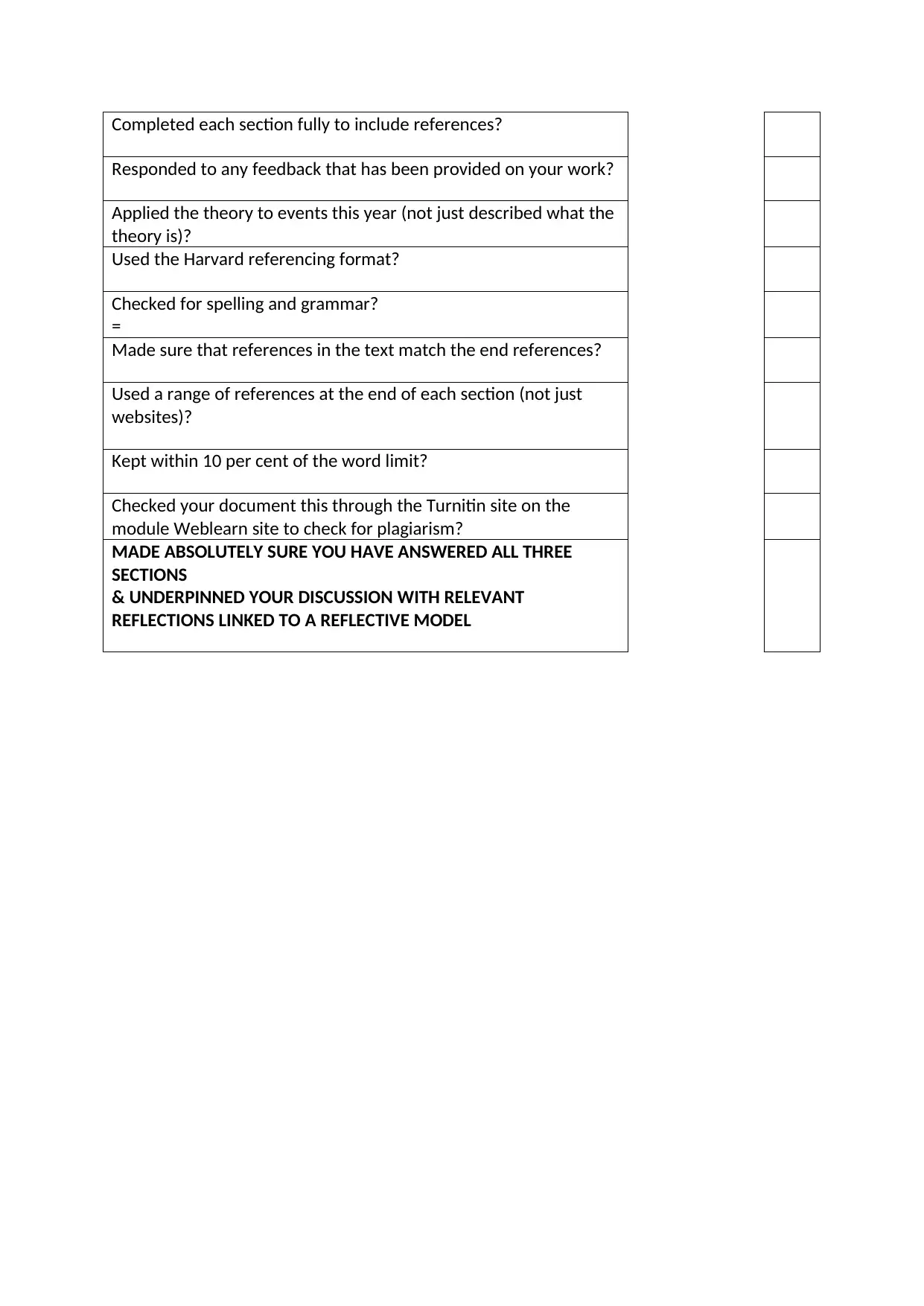
Completed each section fully to include references?
Responded to any feedback that has been provided on your work?
Applied the theory to events this year (not just described what the
theory is)?
Used the Harvard referencing format?
Checked for spelling and grammar?
=
Made sure that references in the text match the end references?
Used a range of references at the end of each section (not just
websites)?
Kept within 10 per cent of the word limit?
Checked your document this through the Turnitin site on the
module Weblearn site to check for plagiarism?
MADE ABSOLUTELY SURE YOU HAVE ANSWERED ALL THREE
SECTIONS
& UNDERPINNED YOUR DISCUSSION WITH RELEVANT
REFLECTIONS LINKED TO A REFLECTIVE MODEL
Responded to any feedback that has been provided on your work?
Applied the theory to events this year (not just described what the
theory is)?
Used the Harvard referencing format?
Checked for spelling and grammar?
=
Made sure that references in the text match the end references?
Used a range of references at the end of each section (not just
websites)?
Kept within 10 per cent of the word limit?
Checked your document this through the Turnitin site on the
module Weblearn site to check for plagiarism?
MADE ABSOLUTELY SURE YOU HAVE ANSWERED ALL THREE
SECTIONS
& UNDERPINNED YOUR DISCUSSION WITH RELEVANT
REFLECTIONS LINKED TO A REFLECTIVE MODEL
⊘ This is a preview!⊘
Do you want full access?
Subscribe today to unlock all pages.

Trusted by 1+ million students worldwide
1 out of 9
Related Documents
Your All-in-One AI-Powered Toolkit for Academic Success.
+13062052269
info@desklib.com
Available 24*7 on WhatsApp / Email
![[object Object]](/_next/static/media/star-bottom.7253800d.svg)
Unlock your academic potential
Copyright © 2020–2025 A2Z Services. All Rights Reserved. Developed and managed by ZUCOL.




